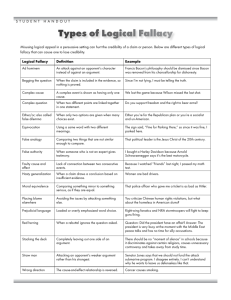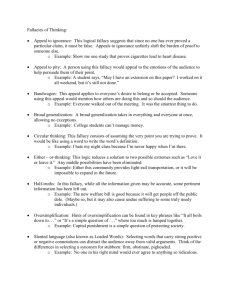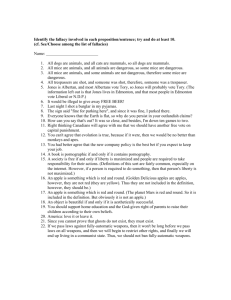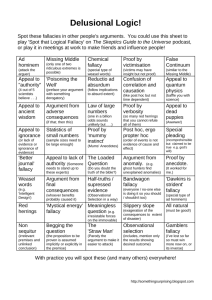Unit 1A - Gordon State College
advertisement
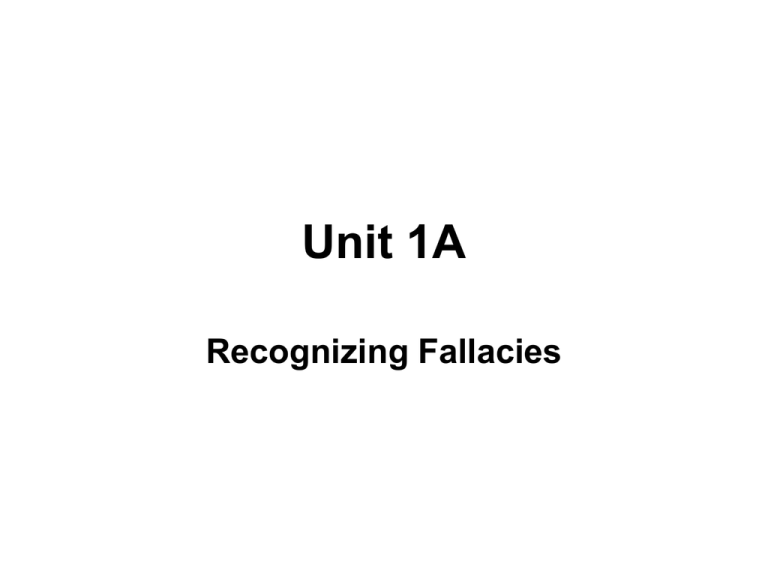
Unit 1A Recognizing Fallacies LOGIC Logic is the study of the methods and principles of reasoning. ARGUMENT In this course, the term argument refers to reasoned or thoughtful processes. Specifically, an argument uses a set of facts or assumptions, called premises, to support a conclusion. FALLACIES A fallacy is a deceptive argument—an argument in which the conclusion is not well supported by the premises. FALLACY STRUCTURES • • • • • Appeal to Popularity False Cause Appeal to Ignorance Hasty Generalization Limited Choice • • • • • Appeal to Emotion Personal Attack Circular Reasoning Diversion Straw Man APPEAL TO POPULARITY The fallacy of appeal to popularity (or appeal to majority) uses the fact that large numbers of people believe or act some way as evidence that the belief is correct. That is, many people believe p is true; therefore . . . p is true. EXAMPLE: Microsoft makes the best computer operating system. After all, more people use Windows than any other operating system. FALSE CAUSE The fallacy of false cause uses the fact that one event came before another as evidence that the first event caused the second event. That is, A came before B; therefore . . . A caused B. EXAMPLE: Jane took some cold medication before her math test. She made a 100 on the test. The cold medication made Jane ace her math test. APPEAL TO IGNORANCE The fallacy of appeal to ignorance uses ignorance (lack of knowledge) about the truth of a proposition to concluded the opposite. That is, there is no proof that p is true; therefore . . . p is false. EXAMPLE: Scientist have not found any evidence of Bigfoot. Therefore, anyone who claims to have seen Bigfoot must be hallucinating. HASTY GENERALIZATION The fallacy of hasty generalization draws a conclusion from an inadequate number of cases or cases that have not been sufficiently analyzed. That is, A and B are linked a few times; therefore . . . A causes B (or vice versa). EXAMPLE: Three cases of brain cancer have occurred in people who use cell phones. Therefore, cell phones must cause these illnesses. LIMITED CHOICE The fallacy of limited choice (or false dilemma) artificially precludes choices that ought to be considered. That is, p is false; therefore . . . only q can be true. EXAMPLE: “You don’t support the President, so you are not a patriotic American.” APPEAL TO EMOTION The fallacy of appeal to emotion uses a positive emotional response to as a tool of persuasion. That is, p is associated with a positive emotional response; therefore . . . p is true. EXAMPLE: In a commercial for Michelin tires, a picture of a baby is shown with the words “because so much is riding on your tires.” PERSONAL ATTACK The fallacy of personal attack (ad hominem) uses a dislike of a person or group making an argument to conclude the argument is not valid. That is, I have a problem with the person or group claiming p; therefore . . . p is not true. EXAMPLE: There is no way Senator Smith’s bill can help the cause of gun control because he is one of the biggest recipients of campaign contributions from the National Rifle Association. CIRCULAR REASONING The fallacy of circular reasoning just restates the premise in different words. That is, p is true; p is restated in different words. EXAMPLE: Schools must implement a zero tolerance policy toward drug use, because any tolerance of drugs is unacceptable. DIVERSION The fallacy of diversion (or red herring) diverts the attention from one issue to another (related) issue. That is, p is related to q and I have an argument concerning q; therefore . . . p is true. EXAMPLE: We should not drill for oil in the Alaskan National Wildlife Refuge (ANWR), because we have too many gas-guzzling automobiles as it is. STRAW MAN The fallacy of straw man makes an argument based on a distortion of someone’s ideas or beliefs. That is, I have an argument concerning a distorted version of p; therefore . . . I hope you are fooled into concluding that I have an argument concerning the real version of p. EXAMPLE: See Exercise 36 on page 20.

